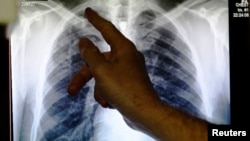Researchers developing a next generation tuberculosis drug say they are getting good results with a combination treatment that promises to work faster and be cheaper than current medicines.
In the latest in a series of tests, the new tuberculosis treatment, called PaMZ, outperformed current drugs, clearing twice as much TB bacteria from patients’ saliva.
“So we’re saying that within two months of treatment, that this treatment could potentially be twice as effective, which we thought was a groundbreaking finding,” explained Rodney Dawson, MD, of the University of Cape Town.
He is the lead author of a paper reporting the results in the British medical journal The Lancet. The study involved more than 200 patients, some with drug-resistant TB and others who had more treatable forms of the disease.
PaMZ was effective in both groups, and also safe, showing minimal side effects.
Dawson said PaMZ can also be used with HIV/AIDS patients, “which is a big concern with the current medication because of problems with the HIV medications interacting with TB drugs.” Millions of tuberculosis patients are also infected with HIV.
Dawson said the new drug will need to be taken for a much shorter period of time — six months or less, compared to as long as two years for the current treatment. That could make a big difference because many TB patients don’t stick with the long treatment protocol.
PaMZ is a combination of three drugs, an antibiotic (pyrazinamide), which is currently used against TB, plus two others not currently approved for TB use (pretomanid and moxifloxacin).
The final round of clinical trials for PaMZ, enrolling 1,500 patients in Africa, Asia, Latin America, and Eastern Europe, is now underway. If all goes well — and it doesn’t always go well — but if it does, a new treatment for tuberculosis should be available after that round ends, about three years from now.
“So hopefully, before the end of this decade, we would see a new treatment,” Dawson said in a telephone interview.
The South African pulmonologist added that the new drug would bring down the cost of treatment, to just one-tenth of what current medications for multi-drug resistant TB cost.






